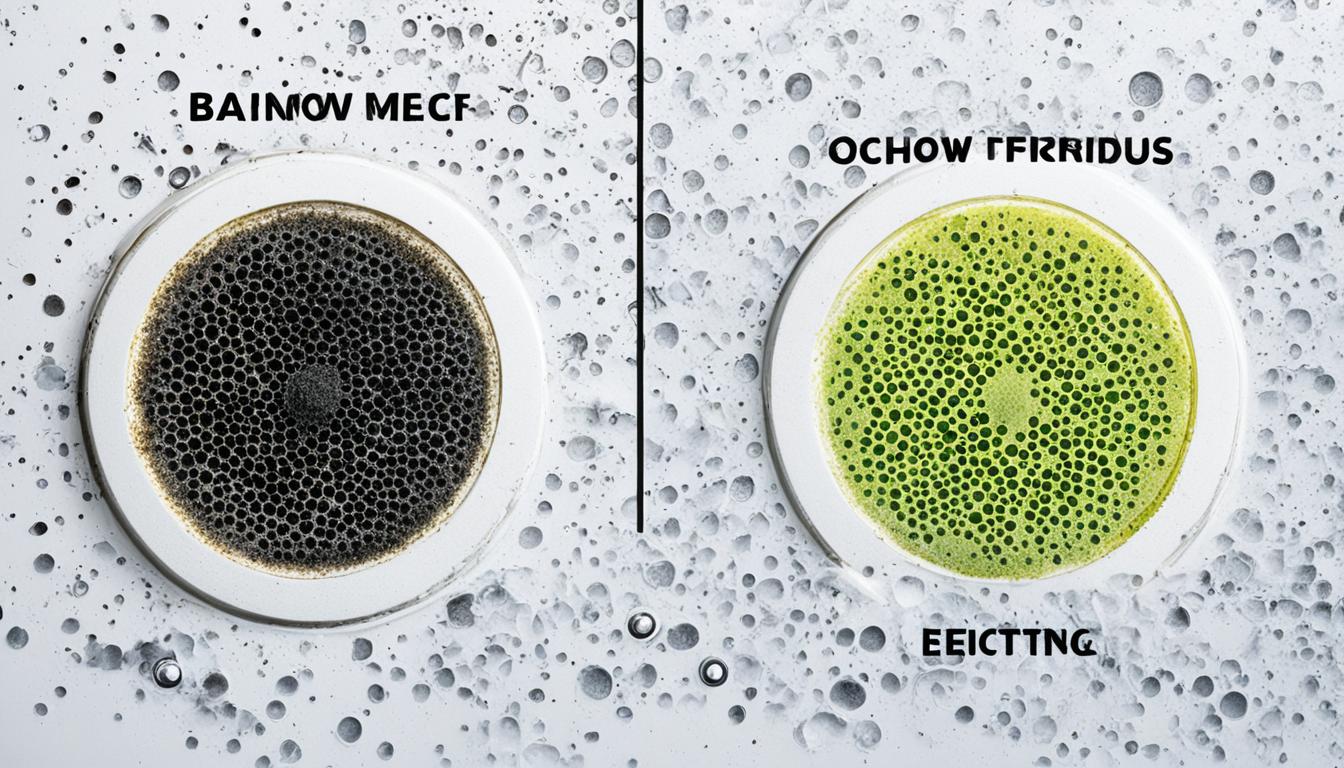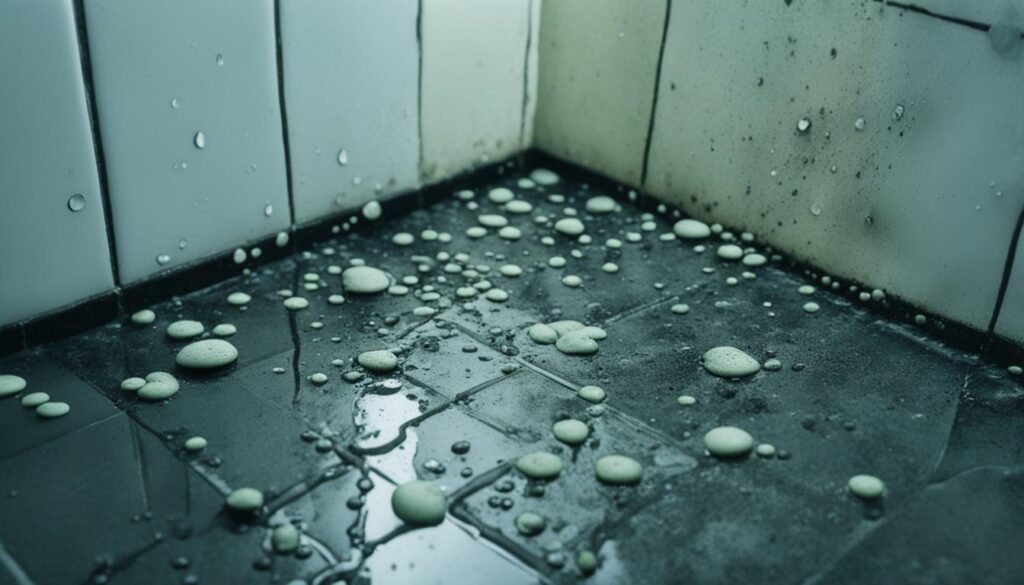
Understanding Bathroom Fungus Growth Causes
Having fungus growth in your bathroom can be a real nuisance. Not only is it unsightly, but it can also pose health risks and damage your bathroom surfaces. Understanding the causes of bathroom fungus growth is essential for effective identification and prevention. In this article, we will explore the different types of bathroom fungi, discuss how to identify them, and provide practical tips for preventing and removing them.
Key Takeaways:
- Bathroom fungus growth can be caused by factors such as excess moisture, poor ventilation, and organic material.
- Identifying the specific type of bathroom fungus is crucial to determine the appropriate treatment and prevention methods.
- Common types of bathroom fungi include black mold, mildew, and yeast.
- Regular cleaning, proper ventilation, and controlling moisture levels are key in preventing bathroom fungus growth.
- If you notice any fungus growth in your bathroom, it’s important to address it promptly to avoid further damage and potential health issues.
Identifying Bathroom Fungus Types
When it comes to dealing with bathroom fungus, it’s crucial to know exactly what you’re dealing with. Different types of fungus require different treatment methods, so identifying the specific type present in your bathroom is essential. In this section, we will explore the various common types of bathroom fungi and provide visual cues and descriptions to help you identify them accurately.
1. Mildew
Mildew is a common type of bathroom fungus that thrives in damp and humid environments. It typically appears as gray or white patches on surfaces such as walls, tiles, or shower curtains. Mildew has a powdery or fluffy texture and tends to spread quickly if not addressed promptly. Its musty smell is another key indicator of its presence.
2. Black Mold
Black mold, also known as Stachybotrys chartarum, is a more serious type of fungus commonly found in bathrooms. It appears as black or dark green patches and has a slimy texture. Black mold is known for its toxic properties and can cause health issues, including respiratory problems and allergies. If you notice black mold in your bathroom, it’s crucial to take immediate action to remove it and address the underlying moisture issue.
3. Pink Mold
Contrary to its name, pink mold is not actually a mold but a type of bacteria known as Serratia marcescens. It thrives in moist areas and can easily grow in bathroom fixtures such as showerheads, grout, and silicone caulk. Pink mold appears as slimy pink or orange patches and can sometimes have a distinctive musty odor.
4. Green Mold
Green mold, often called Trichoderma, is another type of bathroom fungus commonly found in damp environments. It appears as fuzzy or powdery green patches on surfaces and can quickly spread if not addressed. Green mold can be especially prevalent in poorly ventilated bathrooms with high humidity levels.
5. Fusarium
Fusarium is a type of fungus that typically appears as pink or reddish-brown patches. It thrives in moist environments and can often be found on water-damaged surfaces such as wallpaper, drywall, or carpet. Fusarium can cause various health issues, including respiratory problems and skin irritation.
Identifying the specific type of fungus in your bathroom can help you choose the most effective treatment method and take appropriate preventive measures. Be observant of any visual cues, such as color, texture, and growth patterns, and take prompt action to address the issue.
| Type of Fungus | Appearance | Texture | Common Locations | Health Risks |
|---|---|---|---|---|
| Mildew | Gray or white patches | Powdery or fluffy | Walls, tiles, shower curtains | Minor respiratory issues |
| Black Mold | Black or dark green patches | Slimy | Bathroom walls, ceiling, tiles | Severe respiratory issues, allergies |
| Pink Mold | Pink or orange slimy patches | Slimy | Showerheads, grout, silicone caulk | Respiratory issues, infections |
| Green Mold | Fuzzy or powdery green patches | Fuzzy or powdery | Bathroom walls, ceiling, tiles | Respiratory issues, allergies |
| Fusarium | Pink or reddish-brown patches | Varies (typically fuzzy or powdery) | Water-damaged surfaces, wallpaper, drywall, carpet | Respiratory issues, skin irritation |
By familiarizing yourself with the different types of bathroom fungi and their characteristics, you can take the necessary steps to effectively address and prevent their growth in your bathroom.

Preventing and Removing Bathroom Fungus
Bathroom fungus can be a persistent and unsightly problem, but with the right prevention and treatment strategies, you can keep your bathroom clean and fungus-free. In this section, we will discuss practical tips and solutions to help you prevent and remove bathroom fungus effectively.
Proper Cleaning Techniques
- Regularly clean your bathroom surfaces with an anti-fungal cleaner to prevent the growth of fungus.
- Pay special attention to areas prone to moisture, such as shower walls, grout lines, and around the toilet.
- Scrub off any visible fungus using a scrub brush or sponge.
- Ensure proper ventilation in your bathroom to reduce excess moisture and inhibit fungus growth.
Maintenance Practices
- Fix any leaks or plumbing issues promptly to prevent water damage and moisture buildup.
- Replace old or damaged caulk and grout to prevent fungus from thriving in these areas.
- Avoid leaving wet towels or bathmats in the bathroom for extended periods; hang them to dry after use.
- Regularly clean and dry your shower curtain or replace it if necessary.
Recommended Products for Fungus Removal
When it comes to treating and removing bathroom fungus, using effective products can make a significant difference. Here are some recommended products:
| Product | Description |
|---|---|
| Bleach | A powerful disinfectant that can effectively kill fungus and prevent its regrowth. |
| Vinegar | A natural and eco-friendly alternative to bleach, vinegar can be used to remove fungus and prevent future growth. |
| Fungicidal Spray | A specialized spray formulated to target and eliminate bathroom fungus. |
| Anti-Fungal Cleaner | A cleaning solution specifically designed to kill and remove fungus from various surfaces in the bathroom. |
Preventing Bathroom Fungus
Prevention is key when it comes to bathroom fungus. By incorporating these practices into your routine, you can significantly reduce the risk of fungal growth:
- Keep your bathroom well-ventilated to minimize moisture levels.
- Avoid leaving damp towels or clothing in the bathroom.
- Wipe down surfaces regularly to remove any moisture.
- Use a squeegee or towel to dry off shower walls and glass doors after each use.
- Ensure your bathroom is adequately insulated to prevent condensation and excess humidity.
By following these prevention and treatment strategies, you can maintain a clean and fungus-free bathroom environment. Taking proactive steps to prevent and remove bathroom fungus will not only improve the aesthetic appeal of your bathroom but also contribute to a healthier living space.

Conclusion
In conclusion, if you have noticed a fungus-like growth in your bathroom, it is crucial to identify its type to effectively address the issue. By understanding the causes behind bathroom fungus growth, you can take necessary steps to prevent its recurrence.
Identifying bathroom fungus types is key to implementing the appropriate treatment. Different fungi may require different approaches for removal and prevention. By carefully examining the visual cues and descriptions provided in this article, you can confidently determine the specific fungus type in your bathroom.
To prevent and remove bathroom fungus, it is important to maintain proper cleaning techniques and follow recommended maintenance practices. Regularly cleaning and drying the bathroom, using appropriate fungicidal cleaners, and ensuring proper ventilation will go a long way in preventing the growth of harmful fungi.
However, if the issue persists or if you have health concerns, it is advisable to consult a professional who specializes in mold remediation. They can provide expert guidance and assistance in dealing with stubborn bathroom fungus and ensuring a safe and healthy environment for you and your family.




